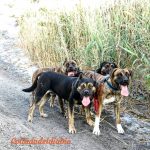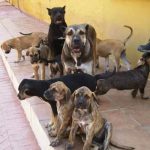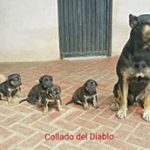Origin
The early history
The migration of the Alans to Europe in the 5th century AD.
The history of the Alano begins with the Alans, a nomadic people that originate from Scythia, an area that stretches over the current Ukraine, Russia, Kazakhstan, Uzbekistan, Turkmenistan, Iran and Afghanistan and Pakistan. The first traces of this people can be found in the first century after Christ. At that time they occupied both areas in the Northern and Southern regions of the Caucasus. When the Huns moved to Europe in the fifth century AD, part of this people followed themand so the Alano was seen for the first time in Europe. Around 409 we find the first traces of the dog species on the Iberian peninsula.
The first Alanos were a lot like the Tibetan Mastiff, but because the Alans were always in motion, their dogs changed their appearance little by little. The dogs evolved according to the tasks they received in the new areas, as well as by crossing with new dog breeds that the Alans encountered on their journeys. By breeding selectively with the Alano, we have come to the esteemed species that we know today.
The Alano in Spain
The Alano, which is also known as the Perro de Presa Español, the Spanish bulldog, Alano of Carcinero, Chato or Perro de Toro, was a much appreciated help to the royal Spanish army. This cooperation between dog and man reached its peak in the Middle Ages and would last until the 19th century. The dog became mainly popular as a hunting dog. Because of this popularity, he could often be seen alongside some influential people from that period, such as Gonzalo De Berceo, Gaston Fébus and many others. They did not hesitate to pay tribute to these beautiful animals in their books and biographies.
Gonzalo de Berceo
Gonzalo de Berceo made the first mention of the Alano.
The priest Gonzalo de Berceo, the first poet in the Spanish language, already mentioned the Alano in one of his poems in 1247: “… They opened their jaws like the Alanos …”. In other ecclesiastical ranks we also find references to the Alano. Less than a century after Berceo, Juan Ruiz, the archpriest of Hita, also writes about the Alano in his poems.
Gaston Fébus
In 1387, Gaston Fébus’s book “The book of Hunting” shows that he describes the Alano in detail. He talks about three different types: the Alan of Butchery, the Alan de Vautre and the friendly Alan. Gaston Fébus was a noble and this is also evident from his book, where he also calls the friendly Alano the “Alano Nobles”.
Fernández de Oviedo
In 1497 the Alano is mentioned in the writings of the famous Spanish historian Fernández de Oviedo. He is talking about a dog given to the prince: “A dog was given to the prince, but he was not very beautiful because he was certainly an Alano or a cross of an Alano … He had powerful legs and was not big.”
Miguel de Cervantes
The Alano Español was extremely suitable for helping in slaughterhouses.
Later we see that Miguel de Cervantes, a Spanish playwright, refers to the Alano. In 1613 he writes the book “El Coloquio de los Perros”. He is talking about the work that the animals do at the Puerta de la Carne, which is located at the Seville slaughterhouse. The Alanos were used there to capture aggressive bulls, to stop escaped animals or to hold the cattle as they were slaughtered.
Other mentions
In the 18th century the first testimonies were written about the Alanos who participated during the Fiestas del Toro Bravo. In 1783 the Alano’s were described as ‘Perro de Presa’ by the academic dictionary.
The Alano as a basis for other dog breeds
The Alano soon became known in the rest of Europe. The English, French and even the Germans imported the dog species to their respective countries, where they then crossed them with their own dogs. Just think of the Bulldog, the Bullenbeiser or the Dogues de Bordeaux. From the crossings with those breeds the Mastiffs, Bullmastiffs, Boxers, Neapolitan Mastins and the Cane Corso came, just to name but a few. During the expeditions of the conquistadores, the Alano also spread to other parts of the world, including Latin America. Here, too, a whole range of other dog breeds emerged, such as the Ca de Bou (Mallorca), the Presa Canario (Canary Islands), the Cimarron (Uruguay), the Fila Brasileiro (Brazil) and the Argentine Dogue (Argentina). The Alano Español is the most important ancestor of all these breeds.
The decline of the Alano Español
The biggest explanation for the massive disappearance of the Alano Español can be found where he once became popular. Due to the invention of advanced firearms, the Alanos became superfluous within the military ranks. Slowly but surely, the trusted companion of the soldiers disappeared from the formations and the race began its decline. In addition, more and more different dog breeds came from abroad in Spain. They were coveted because of their “exotic” character. This contributed to the slow disappearance of the Alano from the Spanish peninsula.
An additional problem that the Alano faced during this time is that the hunt evolved to use the new firearms. The ban on “Ronda” as a hunting method, in which the Alano was used, almost immediately meant the end of the cooperation between hunters and Alanos. In the Ganaderias, the Alanos were also increasingly replaced. The ganaderos replaced their cattle with a new breed, the bull of Monchina, who lived in relative freedom. This made the Alanos redundant in the Ganaderias.
Eventually the population of the Alano was also decimated during the Spanish civil war. The Alanos fell by the thousands. When the Suerte de Perros, who caused the Alano to fight in the arena, was banned in 1883, it almost meant the end for the breed that had once been so esteemed.
The recovery of the Alano Español
At the beginning of the 80’s, the Spanish dog establishments became aware of the disappearance of some dog species and created the “Spanish Breeds Commision”. From that moment onwards, some amateurs searched for the last surviving Alano Españols. They found them with some Spanish purists who had remained faithful to the traditions. They still used the Alano to help with the cattle, something that their ancestors had done before them for so long. These farmers could be found in areas that were difficult to reach in Cantabria, the Basque Country, Castile and Leon. Some 300 copies of the Alano Español lived here, which ultimately formed the basis for the reintroduction of the breed. It was the University of Cordoba that took on the task of genetically legalizing the recovered specimens to ensure the “Alane purity” of those last specimens. Thanks to the university’s research, which took more than 10 years, the Alano was officially recognized in March 2003 by the Royal Spanish Canine Society (RSCE).
The renewal of the breed
The Alano Español
The Alano is currently working on FCI recognition. He is represented in the Spanish Central Canine Society through the ANCAE (Spanish official club of the Alano Español). The ANCAE is in possession of its own origin book, which is the oldest of its kind. Until the recognition of the Alano, the book was the only tool for genealogical control of the breed. The Alano is currently returning to the whole of Spain and is spreading across the world again. The spread is driven by a conservative dynamic that strives to preserve the functional quality of the Alano. The strong skills of the Alano Español combined with its great versatility promote the expansion of the number of owners and the diversification of the species.
In 2006, 711 Alanos were counted. Unfortunately, no reliable counting has taken place since then, so it is impossible to say how many Alanos are currently in the world. It is however possible to make an estimate. Taking into account the high percentage of neonatal deaths in rural settings and the death of adult specimens as part of the hunt, it is estimated that there are currently 600 living Alanos.
It should also be emphasized that there are a number of variations that have always occurred within the breed. The ancestral heterogeneity has generated a random constant within the same litter, so that the future of each individual is determined by its own physical nature: the lightest and most durable for the hunt, the most impressive to tend to livestock. This morphological variability has been attributed in the past to the diversity of tasks imposed on the Alano Español. The genetic department of the University of Cordoba analyzed these variations of type and came to the conclusion that we are indeed dealing with one and the same breed. Currently we are trying to standardize the variety to obtain physiological homogeneity. Psychological homogeneity (courage, determination, nobleness of character, great coziness, …) has been achieved a long time ago.
The challenge for the Alano today is to assert itself as a modern dog by adjusting its full potential to modern society; this while retaining its unique skills and versatility.
Collado del Diablo is a breeding farm in Almeria, in the South of Spain. Sergio Lopez Martinez is a breeder who pays a lot of attention to the external and typical characteristics of the breed. After a thorough preparation, he bought his first Alano in 2006 and the breeding policy is his great passion.
In history, the Alano has already come a long way and fulfilled many functions, but El Camino Del Alano is not yet finished and is still reaching new destinations every day.




